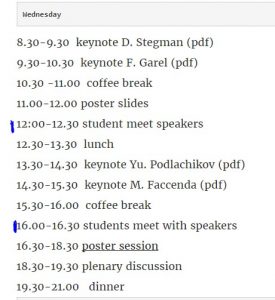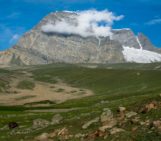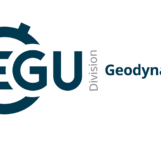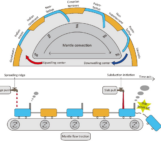
Today, Ági Király, postdoc at CEED (Centre for Earth Evolution and Dynamics) at the University of Oslo, Norway, is sharing her experience of NetherMod.
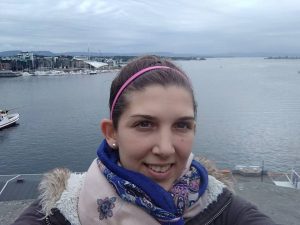 After the wine tasting and karaoke party of yesterday evening, this morning’s keynote speakers had quite a difficult job to shake up the sleepy audience. Dave Stegman even dropped in a promise of a free beer for the most awake student (won by René Gassmöller, cheers!). But what really helped to wake up our little community was the cutting edge science that Dave and later Fanny Garel presented. Dave shared some new modelling results about early earth dynamics, showing the necessity of having a liquid lower mantle to reproduce the Archaeans strong magnetic field. Fanny Garel then showed us results on subduction modelling, reminding us again that “every model is wrong but some are useful”. In the afternoon Yury Podladchikov first talked about how to solve ductile strain localization and porous fluid channelling due to thermo- and hydro-mechanical coupling using parallel computations. It was followed by the talk of Manuele Faccenda showing results of combined geodynamics and seismological modelling to calculate olivine lpo and sks anisotropy in subduction systems. Manuele drew our attention to the artifacts on seismic tomographic models, which can be present due to the mantle anisotropy and the way earthquakes sample the Earth’s interior.
After the wine tasting and karaoke party of yesterday evening, this morning’s keynote speakers had quite a difficult job to shake up the sleepy audience. Dave Stegman even dropped in a promise of a free beer for the most awake student (won by René Gassmöller, cheers!). But what really helped to wake up our little community was the cutting edge science that Dave and later Fanny Garel presented. Dave shared some new modelling results about early earth dynamics, showing the necessity of having a liquid lower mantle to reproduce the Archaeans strong magnetic field. Fanny Garel then showed us results on subduction modelling, reminding us again that “every model is wrong but some are useful”. In the afternoon Yury Podladchikov first talked about how to solve ductile strain localization and porous fluid channelling due to thermo- and hydro-mechanical coupling using parallel computations. It was followed by the talk of Manuele Faccenda showing results of combined geodynamics and seismological modelling to calculate olivine lpo and sks anisotropy in subduction systems. Manuele drew our attention to the artifacts on seismic tomographic models, which can be present due to the mantle anisotropy and the way earthquakes sample the Earth’s interior.
And now about my favourite part in these meetings! A. K. A. why should students always come to meetings and workshops like this. First of all, it’s a relatively small/medium sized meeting, where everyone is staying, eating, drinking, laughing, and brainstorming together all week. So, young scientists have plenty of possibilities to meet fellow young and senior scientists, and do some serious networking. Furthermore, every day we have a half an hour long session where students meet with the keynote speakers during which students and early career researchers have the opportunity to ask questions and discuss with the keynote speakers of the day, without the judging eyes of the other senior participants. This is the place and time where we can ask the seniors to clarify things we didn’t understand, but also to get some more insight into where science is going; what we have to keep always in mind; and what are the biggest challenges in our community. While in the plenary discussion students usually don’t speak up, during this session they can challenge the seniors and exchange ideas.

